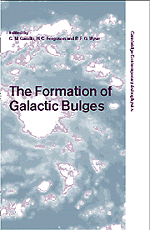Book contents
- Frontmatter
- Contents
- Preface
- Dedication: In Memory of Olin Eggen
- Part 1 Introduction
- Part 2 The Epoch of Bulge Formation
- Part 3 The Timescales of Bulge Formation
- Part 4 Physical Processes in Bulge Formation
- Part 5 Bulge Phenomenology
- Bulge-Disk Decomposition of Spiral Galaxies in the Near-Infrared
- The Triaxial Bulge of NGC 1371
- The Bulge-Disk Orthogonal Decoupling in Galaxies: NGC 4698 and NGC 4672
- The Kinematics and the Origin of the Ionized Gas in NGC 4036
- Optically Thin Thermal Plasma in the Galactic Bulge
- X-Ray Properties of Bulges
- The Host Galaxies of Radio-Loud AGN
- The Centers of Radio-Loud Early-Type Galaxies with HST
- Central UV Spikes in Two Galactic Spheroids
- Part 6 Conference Summary
- Index
The Kinematics and the Origin of the Ionized Gas in NGC 4036
from Part 5 - Bulge Phenomenology
Published online by Cambridge University Press: 10 November 2010
- Frontmatter
- Contents
- Preface
- Dedication: In Memory of Olin Eggen
- Part 1 Introduction
- Part 2 The Epoch of Bulge Formation
- Part 3 The Timescales of Bulge Formation
- Part 4 Physical Processes in Bulge Formation
- Part 5 Bulge Phenomenology
- Bulge-Disk Decomposition of Spiral Galaxies in the Near-Infrared
- The Triaxial Bulge of NGC 1371
- The Bulge-Disk Orthogonal Decoupling in Galaxies: NGC 4698 and NGC 4672
- The Kinematics and the Origin of the Ionized Gas in NGC 4036
- Optically Thin Thermal Plasma in the Galactic Bulge
- X-Ray Properties of Bulges
- The Host Galaxies of Radio-Loud AGN
- The Centers of Radio-Loud Early-Type Galaxies with HST
- Central UV Spikes in Two Galactic Spheroids
- Part 6 Conference Summary
- Index
Summary
The kinematics of stars and ionized gas has been studied near the center of the SO galaxy NGC 4036. Dynamical models based both on stellar photometry and kinematics have been built in order to derive the gravitational potential in which the gas is expected to orbit. The observed gas rotation curve falls short of the circular velocity curve inferred from these models. Inside 10″ the observed gas velocity dispersion is found to be comparable to the predicted circular velocity, showing that the gas cannot be considered on circular orbits. The understanding of the observed gas kinematics is improved by models based on the Jeans Equations, which assume the ionized gas as an ensemble of collisionless cloudlets distributed in a spheroidal and in a disk component.
Introduction
NGC 4036 has been classified S03(8)/Sa in RSA (Sandage & Tammann 1981) and S0− in RC3 (de Vaucouleurs et al. 1991). Its total apparent magnitude is VT = 10.66 mag (RC3). This corresponds to a total luminosity Lv = 4.2 · 1010 at the assumed distance of d = V0/H0 = 30.2 Mpc, where V0 = 1509 ± 50 km s−1 (RSA) and assuming H0 = 50 km s−1 Mpc−1. At this distance the scale is 146 pc arcsec−1.
We measured the kinematics of stars and ionized gas along the galaxy major axis and derived their distribution in the nuclear regions by means of ground-based V-band and HST narrow-band imaging respectively.
- Type
- Chapter
- Information
- The Formation of Galactic Bulges , pp. 170 - 174Publisher: Cambridge University PressPrint publication year: 2000



